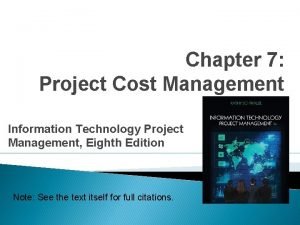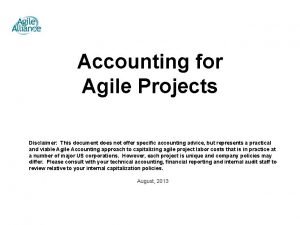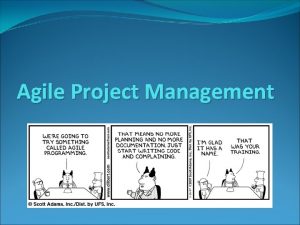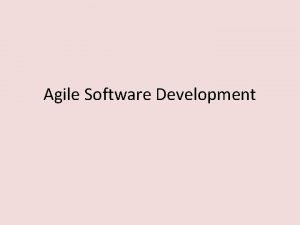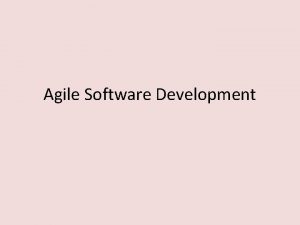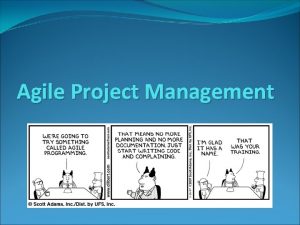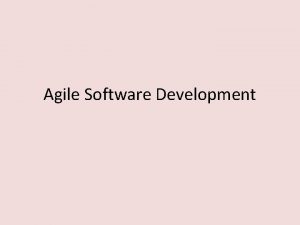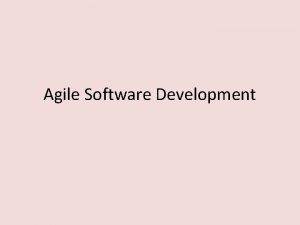Accounting for Agile Projects Disclaimer This document does











- Slides: 11

Accounting for Agile Projects Disclaimer: This document does not offer specific accounting advice, but represents a practical and viable Agile Accounting approach to capitalizing agile project labor costs that is in practice at a number of major US corporations. However, each project is unique and company policies may differ. Please consult with your technical accounting, financial reporting and internal audit staff to review relative to your internal capitalization policies. August, 2013

Goals § Objective: This presentation is intended to clarify and operationalize capitalization rules for Agile projects through defining agile project accounting stages, with an interpretive focus on work and deliverables as outlined in SOP 98 -1 and ASC 350 -40. A measure of success will be an acceptable Agile Capitalization lifecycle to provide capitalization guidance that is accurate, simple, and easy to interpret, control and audit; and increases reporting accuracy and consistency across organizations’ Agile Project Capital Labor Cost Accounting and reduces the risk of expensing costs that should be capitalized. § Agile Project lifecycle § An Agile Clarification re: Project Stages § FAQ’s http: //www. agilealliance. org/programs/agile-accounting-standard-program/

When within the project do we capitalize? Costs can be Capitalized once the “Approval to Start” has been secured and end at the completion of the Application Development stage when the asset is in production for customer use. Preliminary Project Stages Treatment & Preproject tasks Post Implementation Application Development Inception Quick Start Design Storming It 0 It 1 It 2 It 3 It 4 … It n 72 Hrs Cost allocation Expense Capital and Expense Only What How Capitalization Begins Release Capitalization Ends Release … Final set of stories deployed. Release • The Preliminary Project Stage: “What“ (Ends In Inception at the beginning of Design Storming) • The Development Stage: “How “ (Starts with Design Storming) • The Post Implementation Stage: “When” (Begins 72 hours after the last production implementation, when final user acceptance testing and Level 2 support or maintenance handoff is complete)

Preliminary Project Stage The preliminary project stage is any time on the project conducting feasibility and preliminary requirements analysis (“What”) before the project funding is approved by management with appropriate spending authority n Costs incurred during the preliminary project stage should be expensed as incurred. n Examples of activities that are completed in the Preliminary Project Stage: • Strategic decisions are made to allocated resources to initiate the project • High level performance and systems requirements have been determined • Vendors have demonstrated how their software will fulfill requirements (if a vendor or package solution is being considered) • Alternative means of achieving specified performance requirements have been explored (i. e. buy vs. build) • A vendor or consultant has been selected (if appropriate) n For Agile Projects: When the project team has completed feasibility analysis and developed high level “epic stories” and is ready to move on to explore “How” the project will be iteratively designed and developed, the preliminary project stage is complete (previously labeled design storming). This clear bright line marks the project funding, initiation and beginning of capital work. 3

Development Stage Project costs incurred to develop internal use computer software during the application development stage should be capitalized or expensed, depending on the nature of the tasks. § Tasks that can be capitalized are: § Designing the chosen path, including software configuration and software interfaces § Coding – Development and testing § Purchase and Installation of hardware or packaged software § Testing, including parallel processing § Examples of costs that do not qualify for capital treatment during this stage include: § Training costs § Data conversion. However, the building of data conversion programs can be capitalized. The time needed to do the actual data conversion is expensed. § General and administrative costs and overhead costs. § The application development stage is completed after final user acceptance testing in production. At this stage, monitoring and support is typically transitioned to site ops, (usually 72 hours after deployment to production). § This is when the project has been deemed “substantially complete and ready for use”. 4

Development Stage § Additional details of capitalizable costs include: § Fees paid to third parties for services provided to develop the software during the application development stage. § Short-term leases and service agreements for the provision of third-party owned infrastructure such as hardware, system software and middleware software which are necessary to support the application software development. § The cost of internal and external labor which is directly associated with development (design, build, test) § Third-party infrastructure costs incurred to obtain computer software from third parties. § Refinement of requirements that is performed as part of the development/creation of detailed use cases or stories. (Use cases have a lifecycle and they evolve as they transform and mature from initial discovery in the preliminary project stage (which should be expensed) to more detailed definition and eventually to user acceptance in the application development stage (which should be capitalized). § Costs to develop or obtain software that allows for access or conversion of old data by new systems. 5

Post Implementation Stage n The post-implementation stage includes deployment support, training and evaluation. Internal and external project costs incurred during this stage should be expensed as incurred. n The post-implementation stage includes: · Completing documentation on procedures. · Conducting formal training. · Certifying the operational system. · Preparing for post-implementation review. · Collecting project data and analyzing process data. · Conducting facilitated process review. · Routine “maintenance” activities, including fixing regression bugs, routine security reviews, refactoring code 6

FAQ’s Confidential - Do Not Distribute or Copy 7

What is a Capital Asset? "Capital Assets“ are tangible or intangible assets having significant value that are used in operations and that have initial useful lives extending beyond a fiscal year. ” § By capitalizing in the year of purchase/development and depreciating over an asset’s useful life, revenues earned from the investment are matched to the expenses (depreciation) generating them. For IT projects, 3 years is typically used. § High level guidelines are found in Statement of Position 98 -1: Accounting for the Costs of Computer Software Developed or Obtained for Internal Use, which is part of the GAAP (Generally Accepted Accounting Principals) standards.

When can project labor start to be capitalized? A project can be Capitalized when all the following criteria are met: • It is expected that the project will be completed and the software will be used to perform the function intended. • New or upgraded software functionality is being developed. Note: solely extending the software’s useful life without adding additional functionality is a maintenance activity rather than an activity for which the costs should be capitalized. • There is a high probability that the project can be accomplished • The Preliminary project stage is completed. • Management, with the relevant authority, implicitly or explicitly authorizes and commits to funding. Examples of authorization include the execution of a contract with a third party to develop the software, approval of expenditures related to internal development, or a commitment to obtain the software from a third party.

Simple Rules 1. The nature of work performed in the Preliminary and Post Implementation phases is primarily Expense 2. The nature of work in the Development Phase determines whether it will be Capitalized or Expensed: Expense vs. Capitalization What People or Process-Centric Administrative Support Discretionary/Supplemental 3. How Asset-Centric Technical Decision-Authority Asset-Critical Decision tree: IF Minimum expected life of 3 years beneficial use New software functionality AND Completion of preliminary (expense) phase with e-mail from management authorized with appropriate spending authority to fund project as evidence of readiness for design storming (triggering the development/capitalization phase) AND High probability that the product will be completed as planned Work effort is directly related to asset /product design, development, testing or implementation/integration (except for administration, overhead, training and data conversion costs) CAPITALIZE ELSE Expense
 Cost management in agile projects
Cost management in agile projects Wbs for agile projects
Wbs for agile projects Agile test strategy example
Agile test strategy example Usc sponsored projects accounting
Usc sponsored projects accounting Usc sponsored projects accounting
Usc sponsored projects accounting Accounting for agile software development
Accounting for agile software development Document.cookie
Document.cookie What is a general ledger accounting document
What is a general ledger accounting document Formuö
Formuö Typiska drag för en novell
Typiska drag för en novell Nationell inriktning för artificiell intelligens
Nationell inriktning för artificiell intelligens Ekologiskt fotavtryck
Ekologiskt fotavtryck
